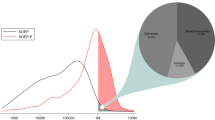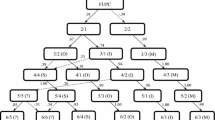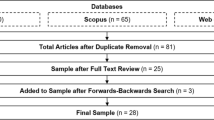Abstract
Empirical studies repeatedly suggest that mergers on average do not create the wealth which CEOs promise (see e.g. Travlos, 1987; Andrade et al., 2001; Moeller et al., 2005; Gaughan, 2007; Martynova and Renneboog, 2008).
Access this chapter
Tax calculation will be finalised at checkout
Purchases are for personal use only
Preview
Unable to display preview. Download preview PDF.
Similar content being viewed by others
References
Ainsworth, M.D., Blehar, M.C., Waters, E., and Wall, S. (1978) Patterns of Attachment: A Psychological Study of the Strange Situation. Hillsdale, NJ: Erlbaum.
Andrade, G., Mitchell, M., and Stafford, E. (2001) New evidence and perspectives on mergers. The Journal of Economic Perspectives 15: 103–120.
Ashton-James, C.E., McCarthy, K.J., and Dranca-Iacoban, A. (2011) Power and the Destruction of Value in Mergers and Acquisitions, in McCarthy, K.J., M. Fiolet, and W.A. Dolfsma (Eds.), The Nature of the New Firm. Cheltenham: Edward Elgar.
Berger, A.N., and D.B. Humphrey (1992) Megamergers in banking and the use of cost efficiency as an antitrust defense. Finance and Economics Discussion Series 203, Board of Governors of the Federal Reserve System (U.S.).
Betton, S., and Eckbo, B.E. (2000) Toeholds, Bid Jumps, and expected payoffs in takeovers. The Review of Financial Studies 13: 841–882.
Bowlby, J. (1973) Attachment and Loss: Vol. 2. Separation: Anxiety and Anger. New York, NY: Basic Books.
Bowlby, J. (1980) Attachment and Loss: Vol. 3. Sadness and Depression. New York, NY: Basic Books.
Bowlby, J. (1982) Attachment and Loss: Vol. 1. Attachment, 2nd ed. New York, NY: Basic Books. (Original work published 1969.)
Brennan, K.A., Clark, C.L., and Shaver, P.R. (1998) Self-report Measurement of Adult Romantic Attachment: An Integrative Overview, in Simpson, J.A., and W.S. Rholes (Eds.), Attachment Theory and Close Relationships (pp. 46–76). New York, NY: Guilford Press.
Buhner, R. (1991) The success of mergers in Germany. International Journal of Industrial Organization 9(4): 513–532.
Campa, J.M., and Hernando, I. (2004) Shareholder value creation in European M&As. European Financial Management 10(1): 47–81.
Carline, N., Linn, S., and Yadav, P. (2002) The Impact of Firm-Specific and Deal-Specific Factors on the Real Gains in Corporate Mergers and Acquisitions: An Empirical Analysis. University of Oklahoma Working Paper.
Cartwright, S., and Cooper, L.C. (1990) The impact of mergers and acquisitions on people at work: existing research and issues. British Journal of Management 1: 65–76.
Chang, S. (1998) Takeovers of privately held targets, methods of payment, and bidder returns. Journal of Finance 53: 773–784.
Chatterjee, S. (1986) Types of synergy and economic value: the impact of acquisitions on merging and rival firms. Strategic Management Journal 7: 119–139.
Chatterjee, A., and Hambrick, D.C. (2011) Executive personality, capability cues, and risk taking: how narcissistic CEOs react to their successes and stumbles. Administrative Science Quarterly 56: 202–237.
Cook, K.S., and Rice, E. (2006) Handbook of Social Psychology John Delamater (Ed.). New York: Springer.
Devos, E., Kadapakkam, P.R., and Krishnamurthy, S. (2008) How do mergers create value? A comparison of taxes, market power, and efficiency improvements as explanations for synergies. Review of Financial Studies 22(3): 1179–1211.
Fraley, R.C., Niedenthal, P.M., Marks, M., Brumbaugh, C., and Vicary, A. (2006) Adult attachment and the perception of emotional expressions: probing the hyperactivating strategies underlying anxious attachment. Journal of Personality 74: 1163–1190.
Fraley, R.C., and Shaver, P.R. (2000) Adult romantic attachment: theoretical developments, emerging controversies, and unanswered questions. Review of General Psychology 4: 132–154.
Gaughan, P.A. (2007) Mergers, Acquisitions and Corporate Restructurings. Hoboken, NJ: John Wiley and Sons.
Geller, D., and Bamberger, P. (2009) Bringing avoidance and anxiety to the job: attachment style and instrumental helping behavior among coworkers. Human Relations 62: 1803–1827.
Gugler, K., Mueller, D.C., and Yurtoglu, B.B. (2003) The Determinants of Merger Waves, Mimeo, University of Vienna.
Hardy, G.E., and Barkham, M. (1994) The relationship between interpersonal attachment styles and work difficulties. Human Relations 47: 263–281.
Haunschild, P. (1994) How much is that company worth? Interorganizational relationships, uncertainty, and acquisition premiums. Administrative Science Quarterly 39: 391–411.
Hayward, M.L.A. and Hambrick, D.C. (1997) Explaining the premiums paid for large acquisitions: evidence of CEO Hubris. Administrative Science Quarterly 42: 103–127.
Hazan, C., and Shaver, P. (1987) Romantic love conceptualized as an attachment process. Journal of Personality and Social Psychology 52: 511–524.
Hazan, C., and Shaver, P. (1990) Love and work: an attachment-theoretical perspective. Journal of Personality and Social Psychology 59: 270.
Hitt, M., Harrison, J., Ireland, R.D., and Best, A. (1998) Attributes of successful and unsuccessful acquisitions of US firms. British Journal of Management 9: 91–114.
Hitt, M.A. and Pisano, V. (2003) The cross-border merger and acquisition strategy: a research perspective, management research. The Journal of the Iberoamerican Academy of Management 1(2): 133–144.
Jensen, M.C. (1986) Agency costs of free cash flow, corporate finance and takeovers. American Economic Review 76: 323–329.
Jensen, M.C. (2003) Agency Costs of Overvalued Equity, work in Progress, Harvard Business School.
Jensen, M.C., and Ruback, R.S. (1983) The market for corporate control: the scientific evidence. Journal of Financial Economics 11: 5–50.
Joplin, J.R., Nelson, D.L., and Quick, J.C. (1999) Attachment behavior and health: relationships at work and home. Journal of Organizational Behavior 20: 783–796.
King, D.R., Dalton, D.R., Daily, C.M., and Covin, J.G. (2004) Meta-analyses of post-acquisition performance: indications of unidentified moderators. Strategic Management Journal 25: 187–200.
Krausz, M., Bizman, A., and Braslavsky, D. (2001) Effects of attachment style on preferences for and satisfaction with different employment contracts: an exploratory study. Journal of Business and Psychology 16: 299–316.
Malmendier, U., and Tate, G. (2004) CEO overconfidence and corporate investment. Journal of Finance 60: 2661–2700.
Marris, R.L. (1964) The Economic Theory of Managerial Capitalism. London: MacMillan.
Martynova, M., and Renneboog, L. (2008) A century of corporate takeovers: What have we learned and where do we stand? Journal of Banking and Finance 32: 2148–2177.
Mikulincer, M., and Florian, V. (1998) The relationship between adult attachment styles and emotional and cognitive reactions to stressful events. In J.A. Simpson and W.S. Rholes (Eds.), Attachment Theory and Close Relationships (pp. 143–165). New York, NY: Guilford Press.
Mikulincer, M., and Shaver, P.R. (2005) Attachment theory and emotions in close relationships: exploring the attachment-related dynamics of emotional reactions to relational events. Personal Relationships 12: 149–168.
Mikulincer, M., and Shaver, P.R. (2007) Attachment in adulthood: structure, dynamics, and change. New York, NY: Guilford Press.
Moeller, S.B., Schlingemann, F.P., and Stulz, R.M. (2004) Firm size and the gains from acquisitions. Journal of Financial Economics 73: 228.
Moeller, S.B., Schlingemann, F.P., and Stulz, R.M. (2005) Wealth destruction on a massive scale? A study of acquiring-firm returns in the recent merger wave. Journal of Finance 60: 75 7–782.
Officer MS. (2007) The price of corporate liquidity: acquisition discounts for unlisted targets. Journal of Financial Economics 83: 571–598.
Park, S.H., Westphal, J.D., and Stern, I. (2011) Set up for a fall: the insidious effects of flattery and opinion conformity toward corporate leaders. Administrative Science Quarterly 56: 257–302.
Puranam, P., and Singh, H. (1999) Rethinking M&A for the High Technology Sector. Wharton School Working Paper, Presented at AOM 2000 meetings.
Ravenscraft, D.J., and Scherer, F.M. (1987) Mergers, Sell-offs and Economic Efficiency. Washington, DC: The Brookings Institution.
Rhoades, S.A. (1998) The efficiency effects of bank mergers: an overview of case studies of nine mergers. Journal of Banking and Finance 22: 273–291.
Rholes, W.S. and Simpson, J.A. (2004) Attachment Theory: Basic Concepts and Contemporary Questions. In W.S. Rholes and J.A. Simpson (Eds.), Adult Attachment: Theory, Research, and Clinical Implications (pp. 3–14). New York, NY: Guilford Press.
Richards, D.A., and Schat, C.H. (2011) Attachment at (not to) work: applying attachment theory to explain individual behavior in organizations. Journal of Applied Psychology 96: 169–182.
Roll, R. (1986) The Hubris hypothesis of corporate takeovers. Journal of Business 59: 197–216.
Schleifer, A., and Vishny, R.W. (1989) Entrenchment: the case of manager-specific investments. Journal of Financial Economics 25: 123–139.
Simon, J.L., Mokhtari, M., and Simon, D.H. (1996) Are mergers beneficial or detrimental? Evidence from advertising agencies. International Journal of Economics and Business 3(1): 69–82.
Travlos, N.G. (1987) Corporate takeover bids, methods of payment, and acquiring firms’ stock returns. Journal of Finance 42: 943–963.
Weston, F.J., Mitchell, M.L., and Mulherin, H.J. (2004) Takeovers, Restructuring and Corporate Governance. Upple Saddle River, NJ: Pearson Prentice Hall.
Williamson, Oliver E. (1985) The Economic Institutions of Capitalism. New York: Free Press.
Copyright information
© 2013 Boyana N. Petkova and Killian J. McCarthy
About this chapter
Cite this chapter
Petkova, B.N., McCarthy, K.J. (2013). Personality. In: Understanding Mergers and Acquisitions in the 21st Century. Palgrave Macmillan, London. https://doi.org/10.1057/9781137278074_9
Download citation
DOI: https://doi.org/10.1057/9781137278074_9
Publisher Name: Palgrave Macmillan, London
Print ISBN: 978-1-349-34051-4
Online ISBN: 978-1-137-27807-4
eBook Packages: Palgrave Business & Management CollectionBusiness and Management (R0)




